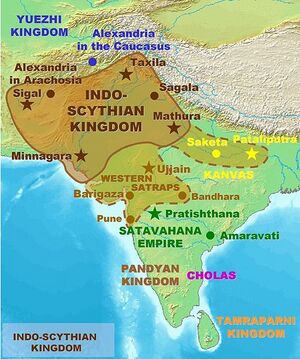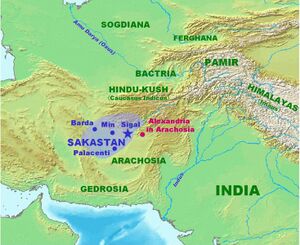Minnagara

Minnagara (मिन्नगर) was an ancient port located in what is now the modern city of Karachi, in the Sindh province of Pakistan. Some historians have identified it with Mandsor in Madhya Pradesh, India. [1]
Variants
- Minnagara मिन्नगर = Minnagala मिन्नगल = Mandsaur मंदसौर (AS, p.746)
- Minna-gara
- Manjábarí
- Min
- Mansúra
Location
Minnagara was a city of the Indo-Scythian kingdom, located on the Indus river in modern Pakistan, north of the coastal city of Barbaricum, or along the Narmada river, upstream of Barigaza.
History
Minnagara is mentioned in the 1st century CE Periplus of the Erythraean Sea:
- "Beyond this region (Gedrosia), the continent making a wide curve from the east across the depths of the bays, there follows the coast district of Scythia, which lies above toward the north; the whole marshy; from which flows down the river Sinthus, the greatest of all the rivers that flow into the Erythraean Sea, bringing down an enormous volume of water (...) This river has seven mouths, very shallow and marshy, so that they are not navigable, except the one in the middle; at which by the shore, is the market-town, Barbaricum. Before it there lies a small island, and inland behind it is the metropolis of Scythia, Minnagara." [2]
A second Minnagara is mentioned in the Periplus, which seems to be upstream of Barigaza:
- 41. "Beyond the gulf of Baraca is that of Barygaza and the coast of the country of Ariaca, which is the beginning of the Kingdom of Nambanus and of all India. That part of it lying inland and adjoining Scythia is called Abiria, but the coast is called Syrastrene. It is a fertile country, yielding wheat and rice and sesame oil and clarified butter, cotton and the Indian cloths made therefrom, of the coarser sorts. Very many cattle are pastured there, and the men are of great stature and black in color. The metropolis of this country is Minnagara, from which much cotton cloth is brought down to Barygaza."
- —Periplus of the Erythraean Sea, Chap. 41 [3]
Ptolemy also mentioned Minnagara, which, according to his explanations, would be along the Narmada river, upstream of Barigaza, and below Ujjain:
- "Moreover the region which is next to the western part of India, is called Indoscythia. A part of this region around the (Indus) river mouth is Patalena, above which is Abiria. That which is about the mouth of the Indus and the Canthicolpus bay is called Syrastrena. (...) In the island formed by this river are the cities Pantala, Barbaria. (...) The Larica region of Indoscythia is located eastward from the swamp near the sea, in which on the west of the Namadus river is the interior city of Barygaza emporium. On the east side of the river (...) Ozena-Regia Tiastani (...) Minnagara".
- —Ptolemy Geographia, Book Seven, Chapter I
Minnagara may be identical with the Manjábarí of the Arab geographers.
Alternatively, "Nagara" being the Sanskrit word for "town", the city itself may have been called "Min", a name found in Isidorus of Charax as a Scythian city in Sakastan (Lassen).
Minnagara as described by Sir H. M. Elliot
Sir H. M. Elliot[4] writes that:
[p.392]: Vincent thinks that the Minnagara of Ptolemy, and of the Periplus usually ascribed to Arrian, is the Manjábarí of the Arab geographers. D'Anville supposes Minnagara to be the same as Mansúra. C. Ritter says it is Tatta, so does Alex. Burnes, because Tatta is now called Sa-Minagur, and Mannert says, Binagara should be read for Minna-gara. These high authorities place it on the Indus. But although goods were landed at Barbarice, the port of the Indus, and conveyed to Minnagara "by the river," there is no reason why Minnagara should have been on that river.
The Periplus merely says, "Minnagara is inland." μεσόΎειος ή μετρόπολις αντής τής Σκνθίας ΜινναΎαρ. Again, the Periplus says, the "Metropolis of the whole country, is Minnagara, whence great quantities of cotton goods are carried down to Barygaza," or Broach, which could scarcely have been the place of export, if Minnagara had been on the Indus. But even allowing it to have been on the Indus, there is every reason to suppose it was on the eastern bank, whereas Manjábarí is plainly stated to be on the western.
Lassen derives the name of this capital of Indo-Scythia from the Sanskrit Nagara, a town, and Min, which he shows from Isidorus Characenus to be the name of a Scythian city. The Sindomana of Arrian may, therefore, owe its origin to this source. C. Ritter says Min is a name of the Sacas; if so, there can be little doubt that we have their representatives in the wild Minas of Rájputána, who have been driven but little to the eastward of their former haunts.
Minnagara is, according to Ptolemy, in Long. 115. 15. Lat. 19. 30, and he places it on the Nerbadda, so that his Minnagara, as well as that of the second quotation from the Periplus, may possibly be the famous Mándúgarh (not far from the river), and the Mánkír which the early Arab Geographers represent as the capital of the Balhará. [See the article "Balhará."]
The fact appears to be that there were two Minnagaras-one on, or near, the Indus; another on the Nerbadda (Narmada). Ptolemy's assertion cannot be gainsaid, and establishes the existence of the latter on the Nerbadda, [and this must have been the Minnagara of
[p.393]: which the Periplus represents Broach to be the port]. The one on, or near, the Indus was the capital of Indo-Scythia, and the Bina-gara, or Agrinagara, of Ptolemy. We learn from the Tuhfatu-l Kirám that in the twelfth century Minagár was one of the cities dependent on Múltán, and was in the possession of a chief, by caste an Agri, descended from Alexander. When we remember that Arrian informs us that Alexander left some of his troops, (including, no doubt, Agrians), as a garrison for the town at the junction of the Indus and Acesines, this affords a highly curious coincidence, which cannot, however, be further dilated upon in this place.1
Min city in Parthian Stations

Parthian Stations by Isidore of Charax, is an account of the overland trade route between the Levant and India, in the 1st century BCE, The Greek text with a translation and commentary by Wilfred H. Schoff. Transcribed from the Original London Edition, 1914. This record mentions about city named Min, the place is the royal residence of the Sakas in Sistan. The presence of the Sakas in Sakastan in the 1st century BCE is mentioned by Isidore of Charax in his "Parthian stations". He explained that they were bordered at that time by Greek cities to the east (Alexandria of the Caucasus and Alexandria of the Arachosians), and the Parthian-controlled territory of Arachosia to the south:
- "Beyond is Sacastana of the Scythian Sacae, which is also Paraetacena, 63 schoeni. There are the city of Barda and the city of Min and the city of Palacenti and the city of Sigal (Cf. Nimrus of the Rustam story in the Shah Nama); in that place is the royal residence of the Sacae; and nearby is the city of Alexandria (and nearby is the city of Alexandropolis), and six villages." Parthian stations, 18.[5]
मिन्नगर = मिन्नगल
मिन्नगर = मिन्नगल (AS, p.746): = मंदसौर : लेटिन के पेरिप्लस नामक यात्रावृत (प्रथम शती ई.) में इस भारतीय नगर का नामोल्लेख है. इस मेम्बारस (Membarus) नामक राजा की राजधानी बताया गया है. कुछ विद्वानों के मत में यह नगर मंदसौर या दशपुर (मध्य प्रदेश) है और मेम्बारस, क्षहरात नरेश नहपान. फ्लीट ने मिन्नगर का अभिज्ञान दोहद से किया है (जर्नल ऑफ दि एशियाटिक सोसाइटी, 1912, पृ.708). किंतु पेरिप्लस में इस नगर की स्थिति का जो विवरण है (बेरीगाज़ा या भृगुकच्छ से 2 डिग्री पूर्व और 2 डिग्री उत्तर) उससे पूर्वोक्त अभिज्ञान ही ठीक जान पड़ता है.[6]
External links
See also
References
Back to General History

